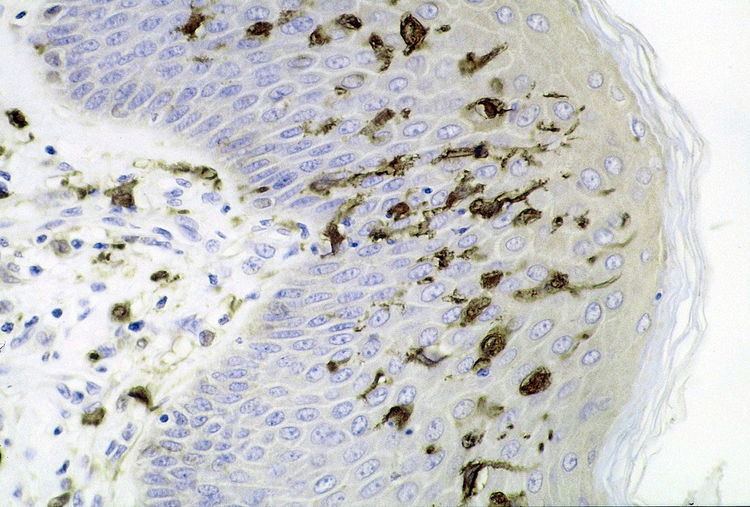 | ||
Langerhans cells are dendritic cells (antigen-presenting immune cells) of the skin and mucosa, and contain organelles called Birbeck granules. They are present in all layers of the epidermis except the stratum corneum, which protects against infections, and are most prominent in the stratum spinosum. They also occur in the papillary dermis, particularly around blood vessels, as well as in the mucosa of the mouth, foreskin, and vagina. They can be found in other tissues, such as lymph nodes, particularly in association with the condition Langerhans cell histiocytosis (LCH).
Contents
Function
In skin infections, the local Langerhans cells take up and process microbial antigens to become fully functional antigen-presenting cells.
Generally, dendritic cells in tissue are active in the capture, uptake and processing of antigens. Once dendritic cells arrive in secondary lymphoid tissue, however, they lose these properties while gaining the capacity to interact with naive T-cells.
Langerhans cells derive from primitive erythro-myeloid progenitors that arise in the yolk sac outside the embryo in the first trimester of pregnancy, and under normal circumstances persist throughout life, being replenished by local proliferation as necessary. If the skin becomes severely inflamed, perhaps because of infection, blood monocytes are recruited to the affected region and differentiate into replacement LCs. They are similar in morphology and function to macrophages.
Langerin is a protein found in Langerhans cells, and other types of dendritic cells.
LCH
In the rare disease Langerhans cell histiocytosis (LCH), an excess of cells similar to these cells are produced. However LCH cells stain positive to CD14 which is a monocyte marker and shows a different, hematopoietic origin for the disorder. LCH can cause damage to skin, bone and other organs.
HIV
Langerhans cells may be initial cellular targets in the sexual transmission of HIV, and may be a target, reservoir, and vector of dissemination.
Langerhans cells have been observed in foreskin, vaginal, and oral mucosa of humans; the lower concentrations in oral mucosa suggest that it is not a likely source of HIV infection relative to foreskin and vaginal mucosa.
On March 4, 2007 the online Nature Medicine magazine published the research letter "Langerin is a natural barrier to HIV-1 transmission by Langerhans cells." One of the authors of the study, Teunis Geijtenbeek, said that "Langerin is able to scavenge viruses from the surrounding environment, thereby preventing infection" and "since generally all tissues on the outside of our bodies have Langerhans cells, we think that the human body is equipped with an antiviral defense mechanism, destroying incoming viruses."
HPV
High-risk human papillomaviruses (HPV) are sexually transmitted viruses causally associated with several cancers including cervical, vaginal, anal, and head and neck cancers that cause significant morbidity and mortality worldwide. Over half of all cervical cancer cases are associated with HPV16, the most common of the cancer-causing high-risk genotypes. During its natural life cycle, HPV16 infects the basal cells of the epithelium and interacts with Langerhans cells within the epithelial layer, which are responsible for initiating immune responses against epithelial invading pathogens. However, HPV does not activate Langerhans cells in vitro, and this may represent a key mechanism by which HPV evades immune detection in vivo. Specifically, HPV16 entry into Langerhans cells via the annexin A2/S100A10 heterotetramer results in suppressive signaling and lack of Langerhans cell-mediated immune responses. This Langerhans cell-targeted immune escape mechanism seems to be conserved among different HPV genotypes enabling these viruses to remain undetected in the absence of other inflammatory events.
It was demonstrated that Langerhans cells in HPV-induced cervical lesions were spherical, lacked dendrites, and secreted the suppressive cytokine IL-10 in vivo. The authors further demonstrated that the number of IL-10 secreting immunosuppressive Langerhans cells, and the amount of IL-10 produced in lesions, corresponded with the severity of histopathology and HPV viral load, providing evidence of an active immunosuppressive mechanism employed by HPV that targets Langerhans cells in vivo.
History
The Langerhans cell is named after Paul Langerhans, a German physician and anatomist, who discovered the cells at the age of 21 while he was a medical student. Because of their dendritic nature, he mistakenly identified the cells as part of the nervous system.
